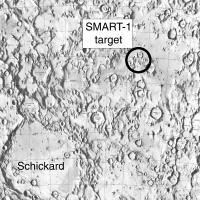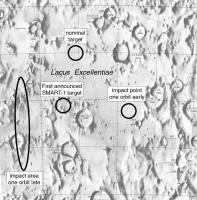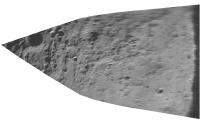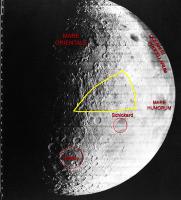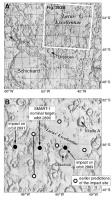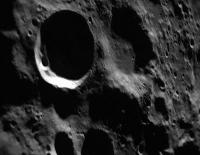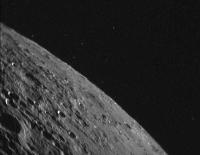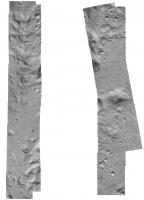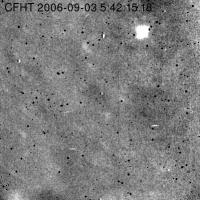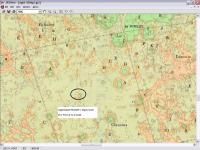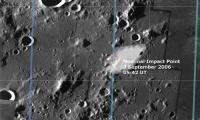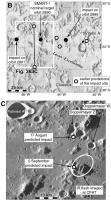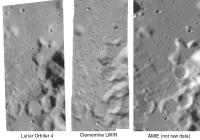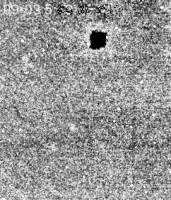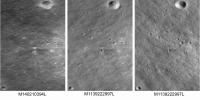Printable Version of Topic
Click here to view this topic in its original format
Unmanned Spaceflight.com _ Lunar Exploration _ SMART-1 impact
Posted by: Phil Stooke Mar 16 2006, 05:26 PM
Emily posted a very nice article in her blog on the SMART-1 lunar impact in September this year. Here's a map of the targeted point:
But as Emily explained, the actual point may be off because of uncertainties about topography.
I'm starting this thread to have a place for news and opinions on it, and - I really hope - maybe some observations at the time from any amateur astronomers out there. This event will be the last event to make it into my atlas. I've left a space for it, and I will make the final maps and fit them in, and then send the stuff off to the publisher.
Phil
Posted by: ljk4-1 Mar 16 2006, 08:41 PM
The March 16 edition of LPOD has an image of the SMART-1
impact region from Lunar Orbiter 4:
http://www.lpod.org/?m=20060316
Interesting quote:
"The good news is that SMART-1 has captured thousands of images of the Moon; the bad news is that because of the daily pressures of flying the mission the team will not have time to start archiving the images and release then until after the impact. Apparently many of the images have not been looked at by anyone!"
Posted by: AlexBlackwell Mar 16 2006, 08:50 PM
"The good news is that SMART-1 has captured thousands of images of the Moon; the bad news is that because of the daily pressures of flying the mission the team will not have time to start archiving the images and release then until after the impact. Apparently many of the images have not been looked at by anyone!"
Now, why doesn't that excuse work for, say, MSSS? Well, I guess SMART-1 doesn't have a "People's Camera" installed.
Posted by: Bob Shaw Mar 16 2006, 09:05 PM
"The good news is that SMART-1 has captured thousands of images of the Moon; the bad news is that because of the daily pressures of flying the mission the team will not have time to start archiving the images and release then until after the impact. Apparently many of the images have not been looked at by anyone!"
Pah! We'd have looked at them if they'd let us...
In the famous words of the Eurovision Song Contest: ESA - Nil Points!
Bob Shaw
Posted by: djellison Mar 16 2006, 09:06 PM
Somehow, they get away with that excuse across the whole of ESA.
Doug
Posted by: odave Mar 16 2006, 09:07 PM
SMART-1 @ Home?
Posted by: helvick Mar 17 2006, 12:35 AM
As a taxpayer who funds an admittedly minuscle component of this I am embarassed. The science is good and theadministration is defensible but the public outreach is abysmal.
Oh well - time to ping my MEP yet again.
Posted by: djellison Mar 17 2006, 08:34 AM
What we need is Esawatch - I'm not a Cowing fan, but at least he asks the awkward questions from time to time.
Doug
Posted by: AlexBlackwell Mar 17 2006, 05:13 PM
Do you really think an "ESAWatch" would work in Europe, given that U.S. "democracy" materially differs from European "democracy"? We (the U.S.) have our faults, as Europeans are more than willing to point out, but there are some ideas that work here that, in my opinion, wouldn't be easily transplantable to Europe. That said, I would love to see someone give ESA a dose of the "Cowing treatment," even if only for the sake of http://en.wikipedia.org/wiki/Schadenfreude.
Posted by: J.J. Mar 22 2006, 04:03 AM
I'm not optimistic about the results; I'm no expert, but has *any* impacting spacecraft or spent booster on the Moon generated a confirmed flash or ejecta sighting from Earth?
Posted by: Phil Stooke Mar 22 2006, 04:27 AM
A very good question.
There is general agreement, I believe, that the Hiten impact on 10 April 1993 was visible, in fact imaged in IR (Google will lead you to the image). Like SMART-1 it was in darkness near the terminator on the near side.
There were poorly documented reports that Luna 2's impact was observed (Sky & Tel. Nov 1960 p. 265). Similarly Luna 5's upper stage rocket (New Scientist, soon after impact, but I don't have the reference yet), and Luna 7 (unpublished MSC internal report in LPI library). Most western observers discounted these reports, and strenuous efforts to view the Ranger impacts came to nothing. But modern CCD and IR imaging should do much better. I personally have little doubt that SMART-1 is at the very least worth making an effort to see, and in fact will probably be imaged.
Phil
Posted by: ljk4-1 Mar 22 2006, 12:37 PM
There is general agreement, I believe, that the Hiten impact on 10 April 1993 was visible, in fact imaged in IR (Google will lead you to the image). Like SMART-1 it was in darkness near the terminator on the near side.
There were poorly documented reports that Luna 2's impact was observed (Sky & Tel. Nov 1960 p. 265). Similarly Luna 5's upper stage rocket (New Scientist, soon after impact, but I don't have the reference yet), and Luna 7 (unpublished MSC internal report in LPI library). Most western observers discounted these reports, and strenuous efforts to view the Ranger impacts came to nothing. But modern CCD and IR imaging should do much better. I personally have little doubt that SMART-1 is at the very least worth making an effort to see, and in fact will probably be imaged.
Phil
Dust cloud produced by Luna-5 impacting the lunar surface:
http://ntrs.nasa.gov/archive/nasa/casi.ntrs.nasa.gov/19790073878_1979073878.pdf
Posted by: J.J. Mar 24 2006, 05:10 AM
Thanks for the answers, people.
Posted by: Phil Stooke Mar 24 2006, 04:44 PM
Very useful new report on the impact:
http://sci.esa.int/science-e/www/object/index.cfm?fobjectid=38988#
Phil
Posted by: The Messenger Mar 24 2006, 07:15 PM
In the famous words of the Eurovision Song Contest: ESA - Nil Points!
Bob Shaw
I wonder if the lens cap is off...
Posted by: Phil Stooke Mar 26 2006, 03:54 PM
This map shows the target locations from the report just referred to. The original point may have been a statement of the nominal perilune rather than the actual impact point, misquoted in the press.
I'm just plotting coordinates on the old LAC chart. The points might be a bit off because of improved selenodetic control since the 60s.
Phil
Posted by: dvandorn Mar 26 2006, 03:57 PM
So, like, they're gonna crash it into, like, Lake Excellent, dude?
Excellent!!!! ((insert bad air guitar riff here))
-the Other S. Doug, Esq.
Posted by: Phil Stooke Mar 26 2006, 04:37 PM
I prefer a Mr Burns-style "Eeeeexcellent!"
Phil
Posted by: RNeuhaus Mar 26 2006, 05:22 PM
I'm just plotting coordinates on the old LAC chart. The points might be a bit off because of improved selenodetic control since the 60s.
Phil
Shall anyone let us know the impact location in the Moon longitudinal and latitud's coordinates. I am not able to ubicate the Lacus Excelentia, forgive me, into an excellent lake!
Rodolfo
Posted by: helvick Mar 26 2006, 05:35 PM
Can't give you lat\lon but http://www.lunarrepublic.com/atlas/sections/g2.shtml, Clausius is on the upper left. Looking at the whole moon it is slightly above and to the left of http://www.lpi.usra.edu/education/timeline/gallery/slide_61.html(the bright crater with very prominent ejecta rays in the southern hemisphere).
Posted by: elakdawalla Jun 23 2006, 09:03 PM
ESA press release today:
http://www.esa.int/esaSC/SEMQFHL8IOE_index_0.html
Looks like they're getting ready for the ending. I was wondering if anybody who knows more about lunar geography than I do could take a look at the unfortunately rather low-quality illustration of the impact site in that story and tell me if it looks like the same location as the one posted here previously.
--Emily
Posted by: Rakhir Jun 23 2006, 09:19 PM
Final operational report for the SMART-1 mission.
http://sci.esa.int/science-e/www/object/index.cfm?fobjectid=39395
Posted by: garybeau Jun 25 2006, 10:42 PM
http://www.esa.int/esaSC/SEMQFHL8IOE_index_0.html
That was an interesting article. The following paragraph got my attention.
I thought all you could do with reaction wheels is change spin and orientation, I didn't realize you
could change velocity as well. Does that only work while in a gravity field or can that work in free space
also?
Posted by: Bob Shaw Jun 25 2006, 11:29 PM
could change velocity as well. Does that only work while in a gravity field or can that work in free space
also?
Gary:
I read that, and pondered also. I think the key was in the concurrent mention of attitude-control jet firings - I have the impression that they were 'hanging' the vehicle on the reaction wheels and firing the jets to create a force applied in the appropriate direction (the RCS jets wouldn't be balanced through the vehicle CG the way that the ion drive would be). It's all down to vectors... ...and the article could have been clearer!
Bob Shaw
Posted by: edstrick Jun 29 2006, 02:29 AM
It's "nice" but not always "necessary" to have balanced attitude control jets, with two jets on opposite sides of a spacecraft's center-of-gravity firing in perfect opposition to rotate the spacecraft without any change in velocity. For a spacecraft doing fine attitude and translational maneuvers in close proximity to another spacecraft, like an Apollo rendezvouis and docking, yes, it's necessary, but often, it's not.
That, of course, is what killed Mars Climate Orbiter. The spacecraft was assymetrical, with one solar panel, and offloaded solar light pressure which slowly spun up the momentum wheels with weekly attitude thruster firings. The firings also imparted a small velocity change on the spacecraft that needed to be included in trajectory calculations. It was.. in the wrong units (english vs metric) throwing off the trajectory models in a particularly insidious way.
Posted by: AlexBlackwell Aug 4 2006, 08:12 PM
http://www.esa.int/SPECIALS/SMART-1/SEMKTCBUQPE_0.html
European Space Agency
4 August 2006
Posted by: rogelio Aug 4 2006, 10:59 PM
“Any harm for the Moon?
Nearly 50 years ago, in 1959, the Russian Luna-2 spacecraft was the first man-made object to hit the Moon. Since then many others have done the same, without any noticeable harm, and SMART-1’s impact will be softer than that of any man-made impactor up till now.
... The crater made by SMART-1 will be 3 to 10 metres wide and perhaps a metre deep. The Moon already has 100 000 craters that are more than four kilometres wide, and every day several small meteoroids make craters as big as SMART-1’s.
Every chemical element present on SMART-1 and in its equipment exists naturally on the Moon. For instance aluminium and iron are very common. Hydrogen, carbon and nitrogen are much scarcer on the Moon, but they arrive naturally onto the surface from the solar wind and from the impacts of icy fragments of comets, which contain many elements. From this point of view, one can think of SMART-1 as an artificial comet. Furthermore, the little hydrazine left in the SMART-1 thrusters will burn immediately at impact. “
...Interesting (and a bit silly if not creepy) that ESA took pains to explain that Smart-1’s crash would have a minimal impact on the moon. I suppose they know their audience well and presume them to be extraordinarily green and caring about our fragile little satellite...
Posted by: ljk4-1 Aug 4 2006, 11:49 PM
Certain Native American groups were upset to learn that Lunar Prospector contained
the ashes of Gene Shoemaker when it crashed on the Moon in 1998, as they consider
our nearest celestial neighbor to be sacred. Muslims also consider the Moon to be
important to their faith.
Posted by: DonPMitchell Aug 6 2006, 06:44 PM
James Oberg had an article some time ago about radical-Islamic objection to space exploration. There is a strong embracing of the Apollo hoax theories too. I guess the greens also object to space exploration, but usually on the grounds of using petroleum in rockets. And of course, if there is even a small RTG in a space probe, some people go nuts.
But remember that Muslims have made important contributions to space. Farouk El-Bas, for example, is a highly honored scientist in the US program.
Radicalism isn't about Islam or Christianity or ecology. It is just ambitious people searching for political opportunities. If you are curious about some theory, read The True Believer by the philosopher, Eric Hoffer.
Oh, my personal favorite crank political protest -- some people objected to NASA's Deep Impact mission, claiming that if the orbit of the comet was perturbed, it might collide with the Earth someday. :-)
Posted by: tedstryk Aug 7 2006, 03:48 PM
I am assuming you mean plutonium
Posted by: ljk4-1 Aug 10 2006, 03:11 PM
Lunar research opportunity
As many of you are aware, the ESA's SMART-1 lunar probe is scheduled to spiral down over the next three weeks, culminating in its impacting the Lunar surface on 3 September 2006.
During its descent through the Moon's tenuous atmosphere, our colleague Claudio Maccone has proposed that as many of us as possible monitor its S-band and X-band beacons, to analyze the nature of the Lunar atmosphere through sounding measurements.
He has secured time on the 32 metre VLBI antenna in Medicina to support these measurements. I know several of you have been doing Deep Space Network monitoring - now is your chance to make a significant amateur contribution to science.
Claudio's research proposal to the Istituto di Radioastronomia appears (in English) at:
http://www.setileague.org/articles/maccone.pdf
Please take a look, and contact Claudio at the email address (clmaccon@libero.it) with
cc to me, if you are able to participate in this important experiment. Thanks.
If any of you are in touch with other amateur groups (SARA, ERAC, AMSAT, etc.) that may be interested in monitoring SMART-1, please feel free to cross-post this email to their various Lists.
--
H. Paul Shuch, Ph.D.
Executive Director Emeritus, The SETI League, Inc.
http://www.setileague.org
n6tx@setileague.org
Posted by: ljk4-1 Aug 11 2006, 02:11 PM
NEWS RELEASE
For immediate release: 2006 July 18
For more information -- Glenn A. Walsh:
Daytime: E-Mail gawalsh@planetarium.cc
Evening: Telephone 412-561-7876
Space Probe Crash on Moon May Be Visible to
Amateur Astronomers with Large Telescopes
Pittsburgh, July 18 – “On the evening of September 2, observers in the eastern half of North America with moderately large telescopes may get a chance to see the European SMART-1 spacecraft crash into the Moon,” according to Friends of the Zeiss Steering Committee Member Francis G. Graham, who is Assistant Professor of Physics and Astronomy at Kent State University.
Professor Graham has prepared a practical guide for amateur observers who wish to try to watch the impact of Smart-1 on the Moon, which can be accessed at the following link:
http://www.venustransit.pghfree.net/gcorner/ImpactMoon.htm
For further information, the following is contact information for Professor Graham:
Francis Graham
East Liverpool Regional Campus
Kent State University
400 East 4th Street
East Liverpool OH 43920
USA
Telephone: 330-382-7466
Electronic Mail: fgraham@kent.edu
Posted by: DonPMitchell Aug 11 2006, 07:29 PM
No, actually there has been some protesting about the use of fossil fuel in rockets, by the same crowd that go around keying SUV's.
Posted by: DonPMitchell Aug 11 2006, 07:33 PM
How does the resolution and coverage from SMART-1 compare to Clementine? Will this be the best source of information for making maps?
I've been tinkering together a solar-system simulator, and I find it ironic that there is better data for Mars than there is for the Moon. You can make a fine texture map from Clementine data, but there is still no really usable elevation data for generating a good bump map. Looks like we will have to wait for LRO for that.
Posted by: Phil Stooke Aug 11 2006, 07:48 PM
Don, the SMART-1 images will be a good source of map data. The situation is a bit complex though, but this is how I see it.
SMART-1 is in an orbit that favours southern hemisphere viewing, so its resolution in the south will be better than in the north. At its best I think it will exceed the Clementine Basemap in resolution. Probably the northern mid to high latitudes will still be better in Clementine, but the southern mid to high latitudes better in SMART-1 data.
But that's just resolution. Lighting must be considered as well. Clem was optimized for multispectral, so they wanted to avoid shadows, and we got high sun over most latitudes. SMART-1 will have lower sun angles where Clem is too high for good mapping. So even where resolution is the same or a bit worse, these new images should be better for mapping in many cases.
Then there is coverage. It's not clear yet that we will have global coverage at the higher resolutions which will be useful. I think I'm right in saying that there will be good global coverage at lower resolution from very early in the orbit phase, but I don't know what the coverage looks like at high resolution. I think the goal was global high res low sun imaging but I don't know what they have achieved.
The USGS digitized lunar orbiter images will also give good lower sun almost-global coverage. How that relates to SMART-1 data in quality, lighting and coverage I couldn't say yet.
Clem altimetry was collected over a short period, so it wasn't a dense dataset. I hope LRO and other missions will provide a MOLA-like dataset, and I think that is the goal. I never believed that altimetry could be as good as MOLA, and I'd love to see the same for the Moon. Too bad Venus can't be that good! Radar will never be as good as laser. I assume even an IR laser would not be great at Venus.
Phil
Posted by: DonPMitchell Aug 11 2006, 08:20 PM
Looking forward do it. For computer rendering of the Moon, the ideal is to actually have the high-sun angle, like what Clementine did. But then compute your own bumb-map shading with altimetry data. Then the shadows will match whatever the Sun's position is.
I've been tinkering with a Venus map for some time. I have a good collection of all the radar data (a box of CDs with high-res Magellan data, all the Venera-15/16 data, the Arecebo maps). One of the technical problems, which fortunately is one of my real-life research interests, is the interpolation of the nonuniformly spaced altimetry measurments. That's something everyone gets wrong.
Posted by: Phil Stooke Aug 11 2006, 08:31 PM
That certainly works for computer rendering, but as image resolution will usually exceed altimetry resolution by at least one order of magnitude, other kinds of mapping require the highest possible resolution low sun data. Ideally we'll have both at some point, and in fact I think there will be some high sun imaging from SMART-1 as well, but I don't know about its resolution or coverage.
Posted by: DonPMitchell Aug 12 2006, 07:59 AM
In theory, with overhead-lit and side-lit views, you should be able to do shape from shading. But computer vision algorithms can be pretty dodgy in practice.
Posted by: Valmir Martins de Morais Aug 12 2006, 05:12 PM
UPDATE FOR THE LUNAR IMPACT OF THE SMART-1
Dear Colleagues,
Please, check the news data and news time, images and graphics updated for lunar impact of the SMART-1 in the homepage of the SL/REA SMART-1 Lunar Impact Project, in the Lunar Section of the Rede de Astronomia Observacional REA – BRAZIL.
These are the last orbit prediction we have for SMART-1.
English Version: http://slrea-smart1lunar-impact-project-ing.blogspot.com/
Best regards,
Valmir Martins de Morais- valmirmmorais@yahoo.com.br
Coordinator for the SL/REA SMART-1 Lunar Impact Project - Secção Lunar REA/BRAZIL
Member of the Moon SMART Impact: Predictions and Observation Campaign.
Posted by: Phil Stooke Aug 17 2006, 02:33 PM
Latest news:
http://www.esa.int/esaCP/SEMTU0Z7QQE_index_1.html
The impact points keep shifting around slightly as timing becomes better known.
Phil
Posted by: djellison Aug 18 2006, 07:59 PM
Looking at Stellarium, (and I'm guessing it's accurate) - both those times are a no-go for Western Europe sadly ![]()
Doug
Posted by: Phil Stooke Aug 30 2006, 01:36 PM
Latest news - Star Tracker images:
http://www.esa.int/SPECIALS/SMART-1/SEMPFY5LARE_0.html
They are reproduced quite dark, but look what happens if you brighten them and do a little reprojection work
the lower one is located here (courtesy LPI):
I have not found the other one yet.
Phil
Posted by: ugordan Aug 30 2006, 01:52 PM
What puzzles me is that the star tracker images appear to be interlaced (!?). It's as though they're using an ordinary alternate-field-readout video camera instead of progressively readout frames. I'd thought that would wreak havoc on the star recognition software.
What gives?
Posted by: Phil Stooke Aug 30 2006, 03:21 PM
There might be a difference between what the camera uses onboard for tracking and what it transmits.
Phil
Posted by: RNeuhaus Aug 30 2006, 05:18 PM
Will SMART-1 impact around the initially planned zone: Lacus Excellentiae localized about North East of Schickard crater? Now, with the recent post of Phil, the probably impact has moved up to North West of Schickard crater? That means that the previous planned impact zone won't be on the Lacus Excellentiae but other site.
Not yet know by sure where will SMART-1 be impacted doesn't it?
Rodolfo
Posted by: ljk4-1 Aug 30 2006, 05:42 PM
Some more undistorted (?) images from the star tracker here:
http://www.esa.int/SPECIALS/SMART-1/SEMPFY5LARE_0.html
Posted by: Phil Stooke Aug 30 2006, 06:08 PM
Rodolfo asked about the impact area - it's still in the same general area, as this map shows:
Phil
Posted by: RNeuhaus Aug 30 2006, 07:03 PM
Many thanks for sharing us. What ways will confirm about the impact site?
- Telescope from Earth
- Radar from Earth?
- Last pictures of star tracking of SMART-1
- SMART-1 altimeter radar
- Anything else?
Rodolfo
Posted by: climber Aug 30 2006, 08:28 PM
I think some of them will be playing and they will be cross-checked for any consistency, won't it?
Rodolfo
Source : Ciel et Espace of September 2006
ESA has organised of network from South Africa to Hawaii able to observe the moon from 7pm to 8 am. Two instruments will be able to detect the melt of aluminium : VLT (in Chile) and Salt in South Africa. Rodolfo, you've rigth in the good spot ![]() . Nevertheless, they say that, due to some hills on the way of the trajectory, impact could occurs 5 to 7 hours before. They'll know better the day before the crash.
. Nevertheless, they say that, due to some hills on the way of the trajectory, impact could occurs 5 to 7 hours before. They'll know better the day before the crash.
Posted by: dilo Aug 30 2006, 08:29 PM
http://www.esa.int/SPECIALS/SMART-1/SEMPFY5LARE_0.html
They are reproduced quite dark, but look what happens if you brighten them and do a little reprojection work
Great work, Phil.
Cannot avoid to process a couple of these images, they are very nice especially after jpeg+interlace removal:
Posted by: Phil Stooke Aug 30 2006, 09:23 PM
Updating on the impact point: here:
http://sci.esa.int/science-e/www/object/index.cfm?fobjectid=39890
is a map of the impact point on a base made of AMIE images. Note that the impact points on my just-posted map are really perilune points, and the impact will occur slightly north of them. I'll fix that.
Phil
Posted by: ustrax Aug 31 2006, 09:09 AM
Foreseen operational duration:
2-2.5 years
Well...It will last more 5 months and one week than the 2.5 years predicted...
You can't rely a mission timetable anymore... ![]()
![]()
Edited: Humm...I was counting with the 14 months transfer period...That doesn't count, doesn't it? ![]()
Posted by: ljk4-1 Aug 31 2006, 02:27 PM
Some Italian radio astronomers are conducting live tests for the upcoming impact:
http://www.geocities.com/priapus_dionysos/bsih.html
Posted by: dilo Sep 2 2006, 09:14 AM
http://www.geocities.com/priapus_dionysos/bsih.html
They say:
But, based on the last http://sci.esa.int/science-e/www/object/index.cfm?fobjectid=39937, impact will occur tomorrow morning, at 5:42 UT!
This is a very bad new, also because europeans will not be able to see impact...
Hope some friend across ocean will do fo us!
Posted by: mars loon Sep 2 2006, 06:09 PM
A new ESA update today, as SMART-1 recovers from a tense 6 hours in "Safe Mode"
and the impact has been delayed by 1 minute as the orbit was raised by 592 meters due to terrain uncertainties
details in the link below, first 2 paragrahs reads as follows:
http://www.esa.int/SPECIALS/SMART-1/SEMV386LARE_0.html
Intense final hours for SMART-1
2 September 2006
The final days of SMART-1's spectacularly successful mission have seen intense activity including a successful recovery from safe mode as mission controllers manoeuvre the craft into a planned Moon crash landing, newly estimated for 07:42 CEST Sunday, 3 September.
A tense, 6-hour recovery from an unexpected safe mode activation, one of the quickest in recent ESA spacecraft operations memory, allowed manoeuvres to proceed nominally during the night of 1-2 September aimed at avoiding a premature Moon impact.
Posted by: RNeuhaus Sep 2 2006, 06:19 PM
But, based on the last http://sci.esa.int/science-e/www/object/index.cfm?fobjectid=39937, impact will occur tomorrow morning, at 5:42 UT!
This is a very bad new, also because europeans will not be able to see impact...
Hope some friend across ocean will do fo us!
Cheer up! Don't sleep overnight!
Rodolfo
Posted by: Rakhir Sep 2 2006, 09:55 PM
An animation made of some star tracker images from 1 Sept is available.
http://www.esa.int/esaCP/SEMZ16BVLRE_index_0.html
http://esamultimedia.esa.int/multimedia/smart-1/060901_Startracker_Auto_Imaging_v3.wmv
Posted by: Phil Stooke Sep 2 2006, 11:46 PM
Nice. The bright crater they mention is Aristarchus.
Phil
Posted by: Phil Stooke Sep 2 2006, 11:54 PM
This is Clementine long wavelength infrared - the best resolution except for the HIRES camera, which only worked well near the poles - at the SMART-1 impact site. The target is slightly east of this strip. I'm looking at the next strip over now.
Phil
Posted by: mars loon Sep 3 2006, 12:58 AM
A new update from Spaceflightnow.com
http://www.spaceflightnow.com/news/n0609/02smart1/
first few paragraphs below, has a few more tidbits compared to the ESA new release
Europe's lunar orbiter to impact the moon Sunday
BY STEPHEN CLARK
SPACEFLIGHT NOW
Posted: September 2, 2006
A European space probe is just hours away from a violent crash into the lunar surface that ground-based scientists hope will help answer debated questions about the Moon's sub-surface.
The exact timing of the impact remains unknown, but European Space Agency officials say their most recent estimates place the event at 0542 GMT (1:42 a.m. EDT) Sunday morning.
Posted by: Phil Stooke Sep 3 2006, 04:14 AM
Well, unfortunately the Clementine LWIR image strips don't cover the nominal impact point. Here is a mosaic of four orbits, containing all the images in the area. The nominal impact point is right in the middle, between the two strips. Each strip is a composite of two orbits. This can be compared with the new AMIE mosaic to see where the strips lie.
LWIR images are difficult to process but give very nice views of the surface, as long as the point you want is covered!
Phil
(PS does anyone else on planet Earth actually use these images?)
Posted by: MizarKey Sep 3 2006, 05:29 AM
Does anyone know if there's anywhere on the web broadcasting live via telescope? I'm telescope challenged and was hoping to see the impact..
Posted by: GravityWaves Sep 3 2006, 05:51 AM
Spaceflightnow ( www.spaceflightnow.com/news ) says the best phots might come from Amateur astronomers, the guys over at nasaspaceflight were running a live thread with impact images from a webcam inside the ESA controll room.
Still no press release....but they have a lot of info on Europe's pre-impact activities as Smart-1 comes to an end
The ESA website says 'ESA-webportal will publish results as soon as they are available late on 2 September and early on 3 September.'
Posted by: ermar Sep 3 2006, 06:10 AM
According to the ESA, the impact took place according to schedule.
http://www.esa.int/SPECIALS/SMART-1/SEMBY5BVLRE_0.html
Posted by: CosmicRocker Sep 3 2006, 07:05 AM
I've been chasing the news, but it has been scarce so far. Apparently an observatory in Hawaii detected a "bright flash," http://www.pennlive.com/newsflash/international/index.ssf?/base/international-2/115725116477070.xml&storylist=international
Posted by: Jyril Sep 3 2006, 08:29 AM
The CFHT image of the flash is available http://www.cfht.hawaii.edu/News/Smart1/.
Posted by: dilo Sep 3 2006, 09:50 AM
Thanks, Jyril... I suspect these are the very first published images of the impact.
About the flash, apparently the explosion is big: it's apparent size is 24 pixel (or 7 arcsec) in the outermost part and 9pixel/2.7arcsec in the inner/most luminous (saturated?) region... these numbers correspond to a "hot gas bubble" of 5-12Km diameter. I do not know if these value are "real" because, even if well above instrument resolution (a fraction of arcsec, see http://www.cfht.hawaii.edu/Instruments/Imaging/WIRCam/), we do not know the atmospheric conditions ![]() and they do not published the FWHM figure... in fact, I suspect that the true moon surface detail are the very blurred (do not considetr the very dark spots or other bright, well defined features probably arising from the sensor) and, based on this, seeing is very bad and SN ratio is high.
and they do not published the FWHM figure... in fact, I suspect that the true moon surface detail are the very blurred (do not considetr the very dark spots or other bright, well defined features probably arising from the sensor) and, based on this, seeing is very bad and SN ratio is high. ![]()
Probably, only some convoluted image can tell us real size of the bubble.
Obviously, SMART crater isn't visible (should be less than 1/60 pixel size) ![]()
Posted by: ugordan Sep 3 2006, 10:30 AM
I suspect the brightness of the flash will be much more useful than measuring its dimensions (which is very dependant on seeing conditions, instrument characteristics and the sort). I wonder if any good spectra were acquired?
Posted by: Sunspot Sep 3 2006, 10:44 AM
The impact site would be a good target for the future Lunar Reconaissance orbiter..
Posted by: edstrick Sep 3 2006, 11:44 AM
Given the low impact speed, this is *not* a hypervelocity impact. Metal and rock debris leaving the impact crater at high velocity will be hot, but probably barely hot enough to glow thermally at visual wavelengths. <I'd like to see a calculation on the maximum kinetic heating possible> There should be some visible flash from remaining hydrazine and maybe shorting batteries and the like.. hard to guess how much.
I'd think a flash would be much more visible at thermal infrared wavelengths.. 5 micrometer or longer. Having an acutal flash dection will pinpoint the impact point better than raw spacecraft L.O.S. timing, I'd presume, and provide a good coordinate for future high and eventually ultra-high imaging.
Posted by: mars loon Sep 3 2006, 12:28 PM
There are some brief reports at the Planetary society website;
http://www.planetary.org/blog/article/00000688/
http://www.planetary.org/blog/article/00000686/ (includes a beautiful mosaic of the impact region from ESA, also at ESA site)
mosaic link:
http://esamultimedia.esa.int/images/smart_1/SMART-1_MoonAMIEMap_H.jpg
there are about 4. check the weblog for more:
Just As Planned
Sep. 2, 2006 | 23:00 PDT | Sep. 3 06:00 UTC
Weblog Archiveby Jennifer Vaughn
SMART-1 scientist Detlef Koschy confirmed that mission control lost the SMART-1 signal at 10:42:19. He reported that folks at ESOC applauded when the "mission ended just as planned." Team members at ESOC are now downloading final pictures. SMART-1 took images up to about 5 minutes before impact.
We also heard from a group of amateur astronomers who have set up at Los Angeles' Griffith Observatory. They did not observe anything unusual, nor did we see anything here at The Planetary Society. We're still waiting to hear from the worldwide network of observatories to see if an impact blast or ejecta plume was seen.
Posted by: Myran Sep 3 2006, 12:42 PM
I can only confirm whats been said, but yes the http://www.ssc.se have that image up now also with a link to the http://www.cfht.hawaii.edu/News/Smart1/
Someone might wonder what the Swedish Space Corporation got to do with SMART? Well SMART was proposed and designed by SSC, and built by http://www.space.se/en/ in Linköping Sweden. After completion SMART was handed over to ESA for launch and the daily operations of the mission.
Posted by: Phil Stooke Sep 3 2006, 03:47 PM
I was just thinking about how many things have hit or landed on the moon... some we might be uncertain about - are the Soviet orbiters still in orbit, for instance? - Luna 10 was high enough that it may still be in orbit - but making a few assumptions, I think SMART-1 may be the 60th spacecraft to reach the surface. I count 20 Lunas (including upper stages of two of them), five Rangers, seven Surveyors, five Lunar Orbiters, 20 bits of Apollo hardware, Hiten, Prospector and SMART-1. I'm not counting things like the Luna 9 landing stage or the Surveyor main engines, ejected before landing, and I'm not counting Luna 17 and Lunokhod 1 (etc) as two items. So a bit of a fudged list.
Some we can't locate on a map - e.g. the Apollo 16 LM ascent stage or the Apollo 15 subsatellite. I think that 50 could be plotted on a map.
Posted by: garybeau Sep 3 2006, 05:49 PM
Not sure if the telescope/camera has the resolution to pick out a crater from the impact, but it sure
looks like there is something visible from the before and after pictures.
Posted by: djellison Sep 3 2006, 05:55 PM
The crater is expected to be 3 x 10m..... you're not going to see if from the ground. You're not going to see if with Hubble. You're not going to see it until LRO starts mapping at 50cm/pixel in a few years time.
Doug
Posted by: garybeau Sep 3 2006, 06:07 PM
True, the actual crater may not be visible, but the ejecta may change the albedo for a much broader area on the order of hundreds of square meters. But even this may not show up with a wide angle view. I look
forward to some high res pictures of the area.
Posted by: Phil Stooke Sep 3 2006, 06:41 PM
The Apollo 14 LM ascent stage impacted in a mare area west of the landing site. Its impact crater was not seen, but its ejecta was identified by Ewen Whitaker (Apollo 16 Preliminary Science Report). (just to show that the crater itself need not be visible).
Phil
A is Apollo 12 image AS12-56-8439, showing the location of B. B is part of Apollo 16 metric camera frame 2508 rectified from its original oblique geometry.
Posted by: RNeuhaus Sep 3 2006, 06:53 PM
Approximate impact zone:
The impact region lies about two-thirds down, directly above the small gap in the mosaic, just south-east of the small crater Palmieri A in the direction of crater Doppelmayer W
ESA estimates that impact occurred at 46.2º West, 34.4º South.
I have enclosed a pinpoint impact zone:
Rodolfo
Posted by: garybeau Sep 3 2006, 07:05 PM
From http://www.space.com/missionlaunches/060903_smart-1_impact.html article.
"Dust and other material ejected off the Moon were expected to possibly be visible to observers with big telescopes back here on Earth."
Posted by: tty Sep 3 2006, 07:28 PM
"Dust and other material ejected off the Moon were expected to possibly be visible to observers with big telescopes back here on Earth."
You'd have to be very fast. Dust is ballistic on the Moon.
tty
Posted by: Phil Stooke Sep 4 2006, 02:21 AM
It's not easy to compare the CFHT image of the flash with the AMIE map, but using the Consolidated Lunar Atlas as an intermediate step, I think this is the location of the flash:
Almost exactly where it was expected, but maybe slightly east of the expected groundtrack. Of course, the observers will do better, but it's interesting to try.
Phil
Posted by: remcook Sep 4 2006, 03:23 PM
some more stuff, including some movies:
http://www.esa.int/esaCP/SEMC378ZMRE_index_0.html
Posted by: Phil Stooke Sep 4 2006, 07:42 PM
This is my current SMART-1 map, as I understand it now, or think I do. The last item to be plugged into my book except for the foreword, which is now being written.
There's a bit of confusion sometimes between periapsis and impact points, but I think I have it sorted out in the top map - B -. White dots are pre-August impact predictions, black dots are August 17 predictions. In the lower image - C -, plotted on an AMIE mosaic (original provided by Bernard Foing with his permission to use it), I show the August 17 and September 2 predictions and what i think is the location of the IR flash seen at CFHT.
Phil
Posted by: remcook Sep 4 2006, 08:00 PM
Fig 363? I am looking forward to your book! It must be well illustrated ![]()
Posted by: Phil Stooke Sep 5 2006, 02:11 PM
Here is a side by side comparison of an area immediately to the west of the SMART-1 impact point (west of it because the Clementine image doesn't cross the impact site itself).
I'm comparing Lunar Orbiter 4 - the new USGS digital version - with Clementine long-wavelength infrared (LWIR) and AMIE. Warning - this is not a fair comparison for AMIE because it's not raw data. This is just cropped out of the big mosaic of the landing area recently posted. This shows LO4 and Clem at full resolution. The AMIE image is enlarged to match the scale, hence its fuzziness.
It is possible that raw AMIE images would equal the resolution of the other two, or get fairly close, near the periapsis latitude. A few other points can be made - the lighting is reversed from Lunar Orbiter, so areas lost in shadow in Orbiter will be seen in AMIE and vice versa - especially important near the poles. And Orbiter coverage of the farside is inferior to this nearside area, so AMIE will at least equal it in many areas. And the Clem LWIR is only available in narrow strips. So we benefit most by having access to all three types of image. AMIE apparently took 20,000 images. When they are released - and especially if good global mosaics are constructed - they will be a very useful addition to lunar databases. And let's not forget that, although several other orbiters are planned, we don't know how many will actually fly successfully.
Phil
Posted by: RNeuhaus Sep 5 2006, 03:44 PM
It is evident that Clementine LWIR has better pictures than Lunar Orbiter 4 and the ones of AMIES looks fuzzier due to the stretch scratch process. Anyway, all of these pictures are of black & white or the Moon has inhereted to only two colores: black and white.
The morphology of Lunar surface has made me to be inquietant. Its tendency of forming the surface does not agree to others places such as Earth and Mars in which they surface are constantly eroded by others process.
Rodolfo
P.D.Corrected the expresion.
Posted by: djellison Sep 5 2006, 03:48 PM
Scratch process?
Doug
Posted by: RNeuhaus Sep 5 2006, 03:58 PM
Doug
Already corrected --> Stretch
Thanks, Rodolfo
Posted by: djellison Sep 5 2006, 03:59 PM
Well - I'll still ask the same question - why do the images look fuzzy because of a 'stretch' process?
Doug
Posted by: RNeuhaus Sep 5 2006, 04:16 PM
Doug
It is according to Phil's post http://www.unmannedspaceflight.com/index.php?s=&showtopic=2424&view=findpost&p=66774
The AMIE image is enlarged to match the scale, hence its fuzziness.
Rodolfo
Posted by: Stu Sep 5 2006, 04:23 PM
One for British Forum members...
http://img.photobucket.com/albums/v509/cumbriansky/lastphoto.jpg
![]()
Posted by: paxdan Sep 5 2006, 04:27 PM
http://images.google.co.uk/images?svnum=10&hl=en&lr=&q=button+moon&btnG=Search
Posted by: Stu Sep 5 2006, 04:35 PM
Don't be silly. Button Moon was just puppets. Everyone knows the Clangers are real... ![]()
Posted by: paxdan Sep 5 2006, 04:54 PM
noooooo say it ain't so.... It's real dammit! It has to be....
Posted by: Stu Sep 5 2006, 05:01 PM
C'mon man, you can see the strings... ain't no strings on Clangers...
("What's that Soup Dragon? Some inconsiderate European guy dropped a ruddy great washing machine sized spaceprobe on your cave and now there's no blue string soup? How terrible!")
Posted by: helvick Sep 5 2006, 06:43 PM
Priceless Stu...
Posted by: ustrax Sep 6 2006, 01:13 PM
forward to some high res pictures of the area.
But there are some slightly visible changes on the ground from the 15secs before and 15secs after the impact images:
http://i16.photobucket.com/albums/b14/ustrax3/smart1.jpg
Posted by: djellison Sep 6 2006, 01:26 PM
I was about to say... How do you know it's changes to the ground and not an ejecta cloud..
Then I thought -hmm - I'll do some image work myself - where's the movie...
Then went to find it and found this ![]()
http://sci.esa.int/science-e/www/object/index.cfm?fobjectid=39968
Doug
Posted by: remcook Sep 6 2006, 01:34 PM
is that a simple differencing of the images wrt the pre-impact image? Looks cool though!
edit - here's the animation of it...you can clearly see somthing hitting from above and then making a crash landing like longjumpers do ![]()
http://www.cfht.hawaii.edu/News/Smart1/#Dust
Posted by: djellison Sep 6 2006, 01:53 PM
I knew I should have done this earlier - not as good as the official one ( but we're not privy to the proper data ) - however something is visible.
Doug
Posted by: climber Sep 6 2006, 04:48 PM
Doug and Remcook,
Yes, that's clearly visible on both animations ![]()
I'm surprised by the behavior of the cloud that seams to go sideway like blown by the wind. Do you feel the same?
Posted by: ugordan Sep 6 2006, 05:35 PM
I don't see the dust drifting sideways. It looks pretty much ballistic to me. Whether or not the dust was kicked up evenly is another story -- it depends which direction the craft was coming in from. If it was coming from a NNE direction, that's about consistent.
Posted by: RNeuhaus Sep 6 2006, 06:44 PM
Besides, I have seen a cloud of dust when the Lunar Module takes off from the Moon in a mpeg film. I think you may discover it at http://www.hq.nasa.gov/alsj/a17/a17v_1880127.mpg.
A light color dust around the takeoff site covered the black sky.
However, I think that the Moon surface is not so dusty as the ones of Mars and also to some Earth places. I was surprised to see that there is not much dust around the take off in spite of the fact the surface has no cement but on an open surface.
Then, I am supposing that the amount of dust of Moon surface must vary according to the some kind of ecological process. The bombardment of meteorites originates the most dust from Moon surface. The rest, no known. For Earth part, the dust is the product from hydro and aeolian force along with the oxidation process caused by the oxigen. But, Moon has no oxygen but it can only be found on silicates that it is very hard to separate from silicate only by after an over than 1,000 -1,500 C. Also, Moon has no aeolian and hydro or any other gas state that might erode the Moon surface to make dust.
Where does the Moon dust comes from? ![]()
Rodolfo
Posted by: djellison Sep 6 2006, 06:50 PM
Micrometeoritic impacts over the past several billion years. The surface of the moon is very very dusty.
Doug
Posted by: RNeuhaus Sep 6 2006, 07:02 PM
Yes, that's clearly visible on both animations
I'm surprised by the behavior of the cloud that seams to go sideway like blown by the wind. Do you feel the same?
It might happen if, let suppose that one of the solar panels were broken away and it is hit on any rocky surface and the Moon dust is blown on the sides. However, the most dust must be ballistic.
Rodolfo
Posted by: RNeuhaus Sep 6 2006, 07:05 PM
Doug
But, not so dusty as the other places I have seen, as an example, the rural ways which lifts much dust than does the rovers on the moon. You can see the rovers going on the Moon and there is not so much dust as does in the Earth on dry ways.
Rodolfo
Posted by: djellison Sep 6 2006, 07:53 PM
Wahahah?
http://www.history.nasa.gov/alsj/a16/a16f.grandprix2.mov
7 -8 seconds in - LOTS of dust.
The surface of the moon is almost ALL dust.
Doug
Posted by: Ames Sep 6 2006, 08:08 PM
http://www.history.nasa.gov/alsj/a16/a16f.grandprix2.mov
7 -8 seconds in - LOTS of dust.
The surface of the moon is almost ALL dust.
Doug
I think that what is non-intuitive here is the fact that, on the moon, even the finest dust settles out as fast as a dropped weight, so dust doesn't hang around for long. Remember the rock vs. feather experiment. This gives the impression of not being as dusty as Mars. But if you were to inject a little atmosphere around the place, the sky would be thick with dust.
So I can see what RNeuhaus is saying but, doug is right, the Moon IS VERY dusty it's just that it settles fast.
Nick
Posted by: RNeuhaus Sep 6 2006, 08:46 PM
So I can see what RNeuhaus is saying but, doug is right, the Moon IS VERY dusty it's just that it settles fast.
Nick
Thanks Nick and Doug for the good note and nice rover movie respectively in which I am a fan of off-road. Yes that I know that Moon is dusty but I was trying to measure about how dusty it is. After seen the rover movie, it is evident in spite of the fact that the rover went rather slow, the dust was lift on around the wheels that is not similar to a desert but a dry road or surface (previously was wet). I agree both of you but what I am saying is from the intuition. However, I recognize that it is difficult to evaluate more realistically it by seeing only from the movie with a rather poor resolution. So the case is closed with a beer in a pub!
Rodolfo
Posted by: garybeau Sep 6 2006, 11:50 PM
http://www.cfht.hawaii.edu/News/Smart1/#Dust
That is some pretty amazing video. If I read the caption correctly, the frame size is 200km x 200km which
makes the dust plume at least 50 - 75 km long. The frames were taken with an infrared camera, are we
seeing the remnent heat from the impact or is the dust popping up into the sunlight?
Posted by: Phil Stooke Sep 7 2006, 12:14 AM
One other thing to consider - you would only need a small amount of residual fuel to produce a cloud of vapor capable of lifting a bit of very fine dust, changing the 'ballistic dust' situation quite a bit.
Phil
Posted by: DonPMitchell Sep 7 2006, 03:44 AM
There were claims made to have seen the Luna-2 impact on the Moon. That seems doubtful with the telescopes of that time, even though the craft (including the rocket 3rd stage) was bigger than SMART-1.
Posted by: AndyG Sep 7 2006, 12:43 PM
makes the dust plume at least 50 - 75 km long. The frames were taken with an infrared camera, are we
seeing the remnent heat from the impact or is the dust popping up into the sunlight?
...or is it the heating of the surface by falling debris?
Whichever it is, given that the plume fades at 50-75km, and lasts for 130 seconds or so, that allows us to look at the ballistics for the most energetic (in terms of range) element of this visible debris.
I see launch angles/ejection velocities ranging from: 24 deg @ 300 m/s, through to a peak around 12 deg @ 500, and fading out at 8 deg @ 700 m/s, to fulfill those criteria. Quite different to the impact angle of <1 deg and velocity ~2000 m/s.
Does that give us any clue to the topography of the impact area?
Andy
Posted by: ljk4-1 Sep 7 2006, 02:17 PM
Dust cloud produced by Luna 5 impacting the lunar surface:
http://ntrs.nasa.gov/archive/nasa/casi.ntrs.nasa.gov/19790073878_1979073878.pdf
Posted by: ustrax Sep 7 2006, 03:47 PM
More on ESA:
http://www.esa.int/esaSC/SEMWX03VRRE_index_1.html
Posted by: dilo Sep 13 2006, 12:09 AM
http://www.esa.int/SPECIALS/SMART-1/SEM8SH7LURE_0.html
Laboratory simulations of the SMART-1 impact performed at the University of Kent, United Kingdom, suggest that the impact may have caused a clearly elongated lunar crater, and produced a high-speed rebounding for the spacecraft...
Posted by: jasonjason May 2 2013, 03:48 AM
Is this the SMART-1 impact crater?
SMART-1 location shown on ACT-REACT QUICKMAP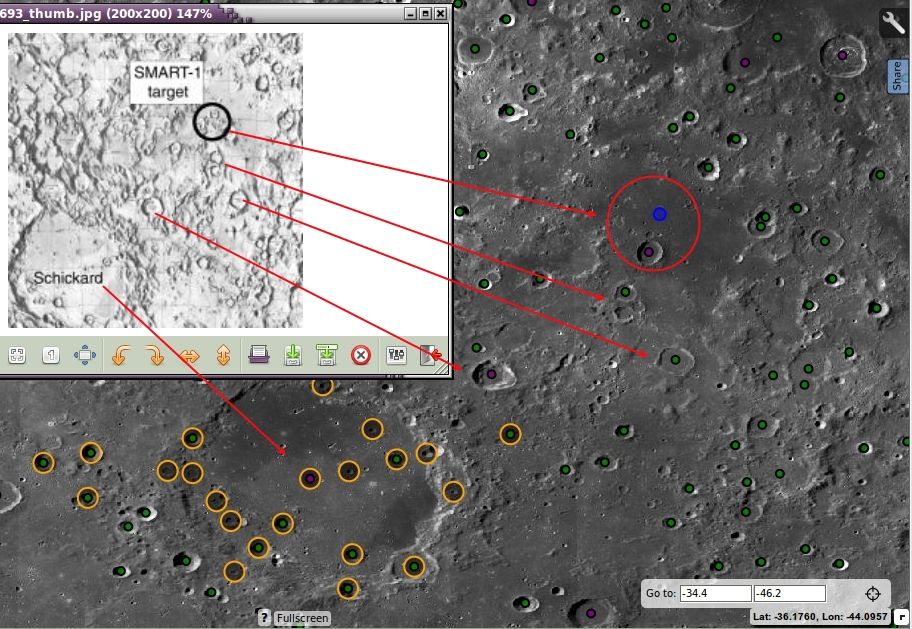
Another set of impact coordinates in the same area but NW of location can be found http://www.esa.int/Our_Activities/Space_Science/SMART-1/Impact_landing_ends_nobr_SMART-1_nobr_mission_to_the_Moon
which states
"SMART-1 ended its journey in the Lake of Excellence, in the point situated at 34.4º South latitude and 46.2º West longitude."
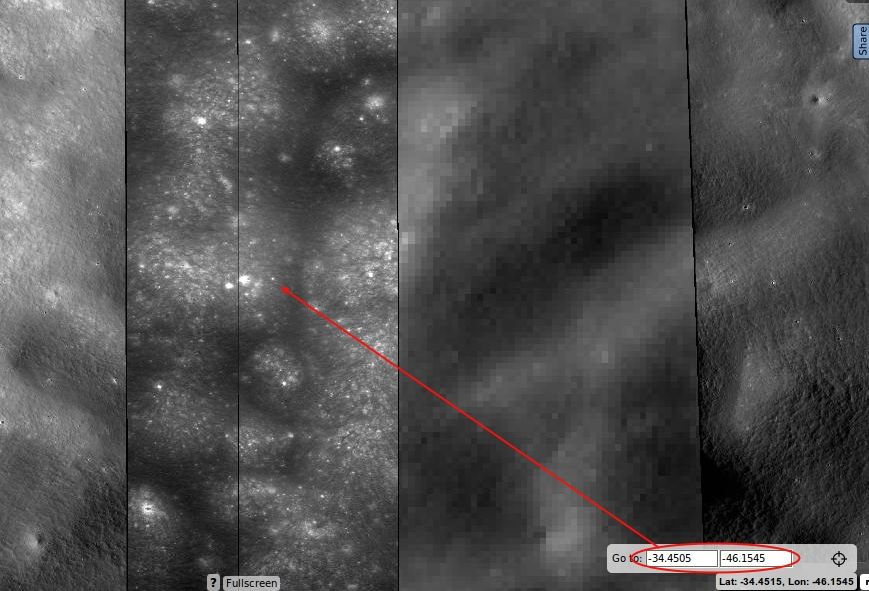
This site shows http://www.esa.int/Our_Activities/Space_Science/SMART-1/SMART-1_impact_simulated_in_a_laboratory_sand-box
This site shows http://www.esa.int/ESA_Multimedia/Images/2006/08/SMART-1_impact_site and lists 46.2º West longitude and 33.3º South latitude as impact location
This site http://www.planetary.org/blogs/emily-lakdawalla/2010/2551.html lists the impact point as 33°S and 46.2°W which is in Doppelmayer Y but nothing shows up at that exact location
This site http://www.universetoday.com/435/smart-1s-final-days/ lists coordinates as 36.44º south of latitude and 46.25º west of longitude, and doesn't appear to have an impact crater.
This site http://www.venustransit.pghfree.net/gcorner/ImpactMoon.htm and lists other interesting information regarding viewing and impact crater creation
This appears to be a good candidate and is located at -34.4502 lat -46.1559 lon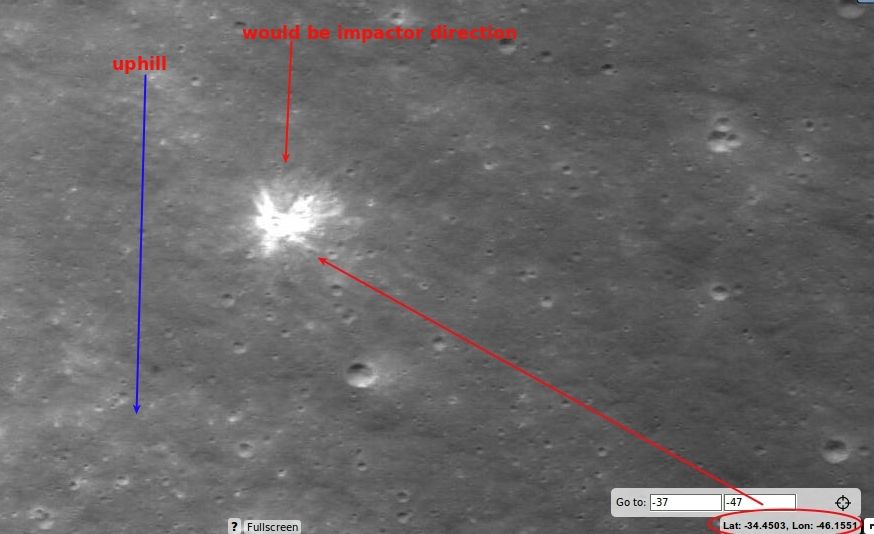
it is a butterfly impact and is on the side of a mountain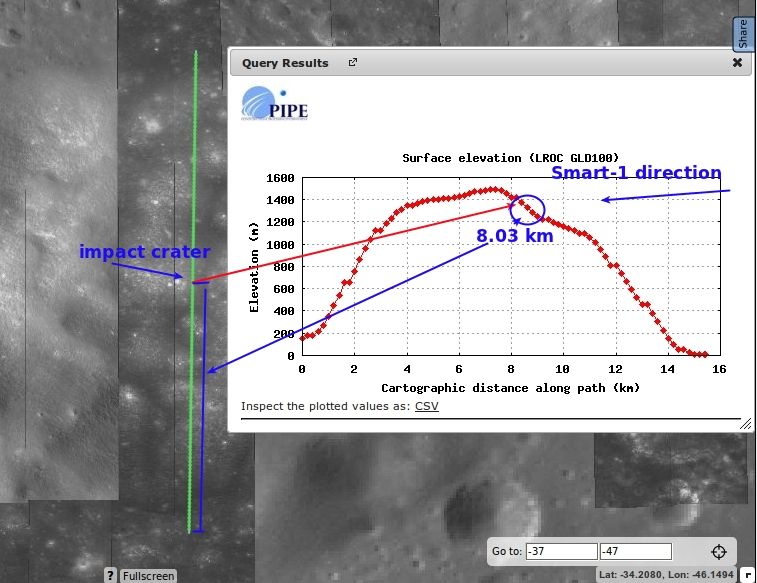
I put in a request @ LRO/LROC Target Observation Request for this area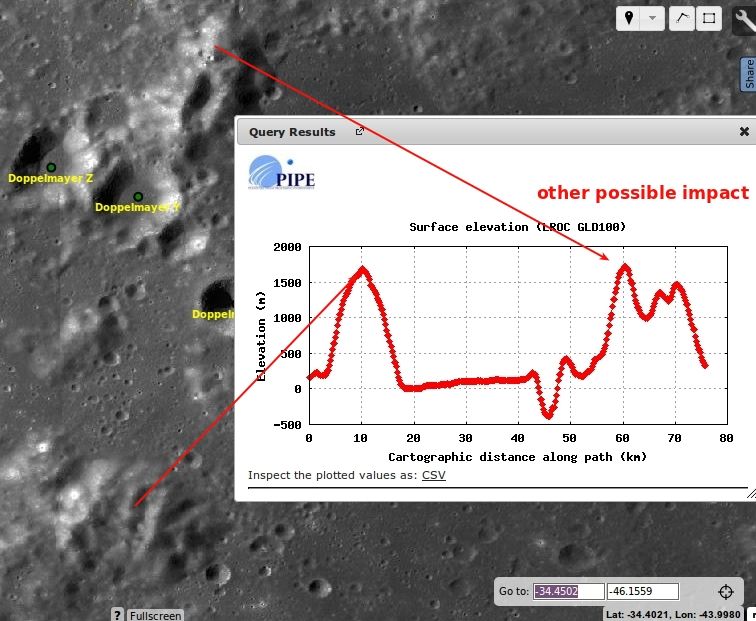
3D views of possible impact area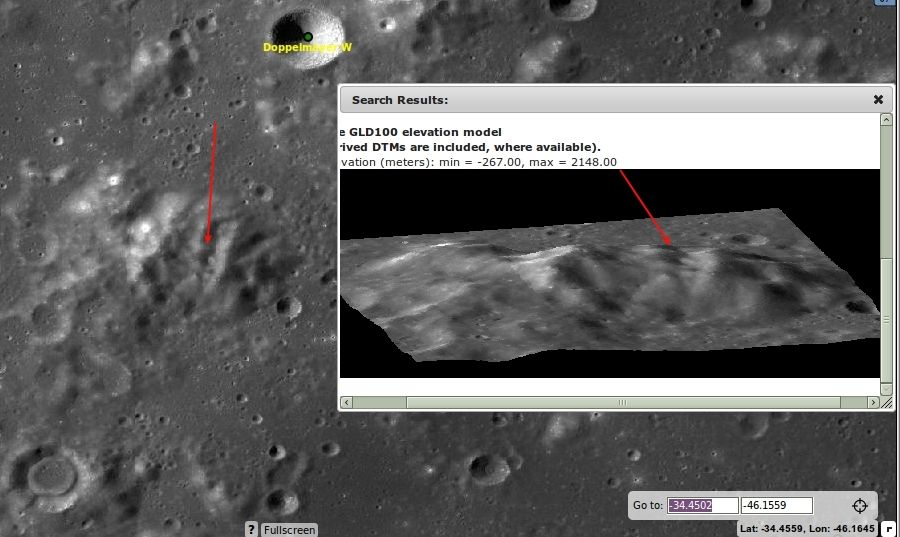
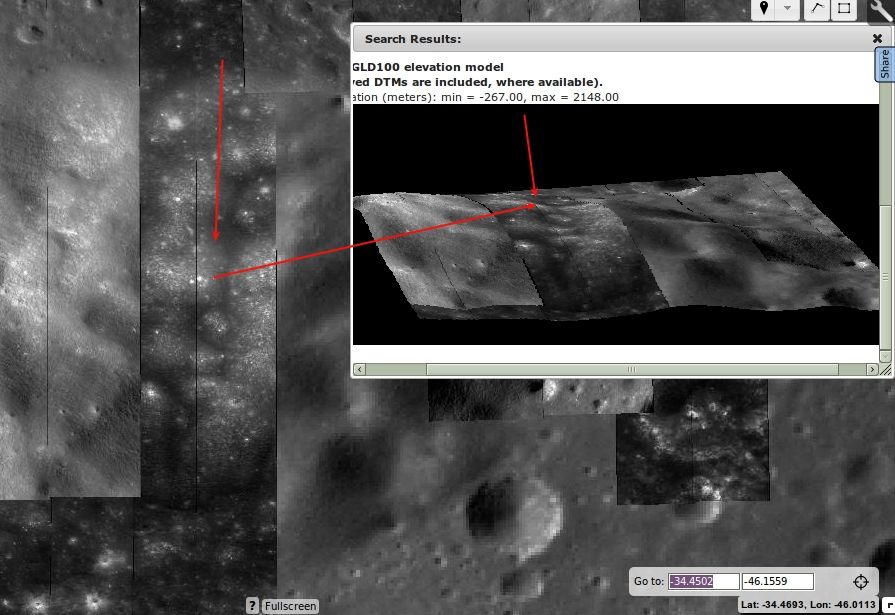
Posted by: Phil Stooke Jan 29 2017, 10:22 PM
I have a new candidate for the SMART-1 impact crater as of about an hour ago!
First I will comment that one problem with the crater identified higher up on this page is that its ejecta deposit is spread around quite a bit of its rim rather than forming a fan extending downrange. We know a lot more about these very low oblique impacts now, from GRAIL, LADEE and my recent observations of Chang'E 1 and two Apollo LM ascent stages. The ejecta should be strongly focussed in the downrange direction.
And so today I looked again, and found this:
These are the only three images. There is an elongated gouge about 22 m long and 3 or 4 m wide. Two images, with morning and afternoon illumination, show the gouge clearly. The third, on the left, is the highest resolution image (0.5 m/pixel) and has local noon illumination - from the north at this southern latitude. It shows a fan of light rays extending south from the gouge (the spacecraft was passing from north to south) with hints of a few dark rays or gaps between bright rays. The size and form match simulations and lab experiments for the impact (see Burchell et al., Icarus, v. 207 (2010) pp. 28–38). The location is 34.262 S, 46.193 W (313.807 E)
Phil
Posted by: nprev Jan 30 2017, 05:27 AM
I admire your persistence! ![]()
What's the next step for confirmation?
Posted by: Gerald Jan 30 2017, 12:55 PM
This looks almost like a bounce. Is there any chance to find consecutive impacts of the resulting debris?
Posted by: Phil Stooke Jan 30 2017, 05:28 PM
There's a chance, as I have possibly seen for the Apollo 12 LM impact, but I don't see anything like that here.
nprev: next step is to take over the world! Or at least convince a few of its inhabitants that I'm right. I will append this to my LPSC poster and we will see what happens.
Phil
Posted by: nprev Jan 31 2017, 12:46 AM
I for one welcome our new cartographic overlord! ![]()
Present for community review and critique; understood.
Posted by: Phil Stooke Sep 23 2017, 11:25 AM
Follow-up story on SMART-1:
http://www.leonarddavid.com/lunar-lost-now-found-crash-site-of-european-moon-probe/
Phil
Posted by: kenny Sep 3 2018, 01:25 PM
ESA Press Release today 3 Sept 18
This greyscale, mottled image shows a patch of the Moon’s surface, and features an intriguing shape towards the top of the frame. This was actually made by a spacecraft – it marks the final resting place of ESA’s SMART-1... with appropriate acknowledgement of Phil's discovery.
http://www.esa.int/spaceinimages/Images/2018/09/SMART-1_s_crash_site
Posted by: Phil Stooke Sep 3 2018, 06:53 PM
I have a short paper currently in review in Icarus about this.
Phil
Posted by: Phil Stooke Nov 14 2018, 01:21 AM
Here is a link to the SMART-1 paper. If you don't have access message me.
Phil
https://www.sciencedirect.com/science/article/abs/pii/S0019103518303774
Posted by: Paolo Nov 14 2018, 06:25 AM
it appears paywalled for me
Powered by Invision Power Board (http://www.invisionboard.com)
© Invision Power Services (http://www.invisionpower.com)
